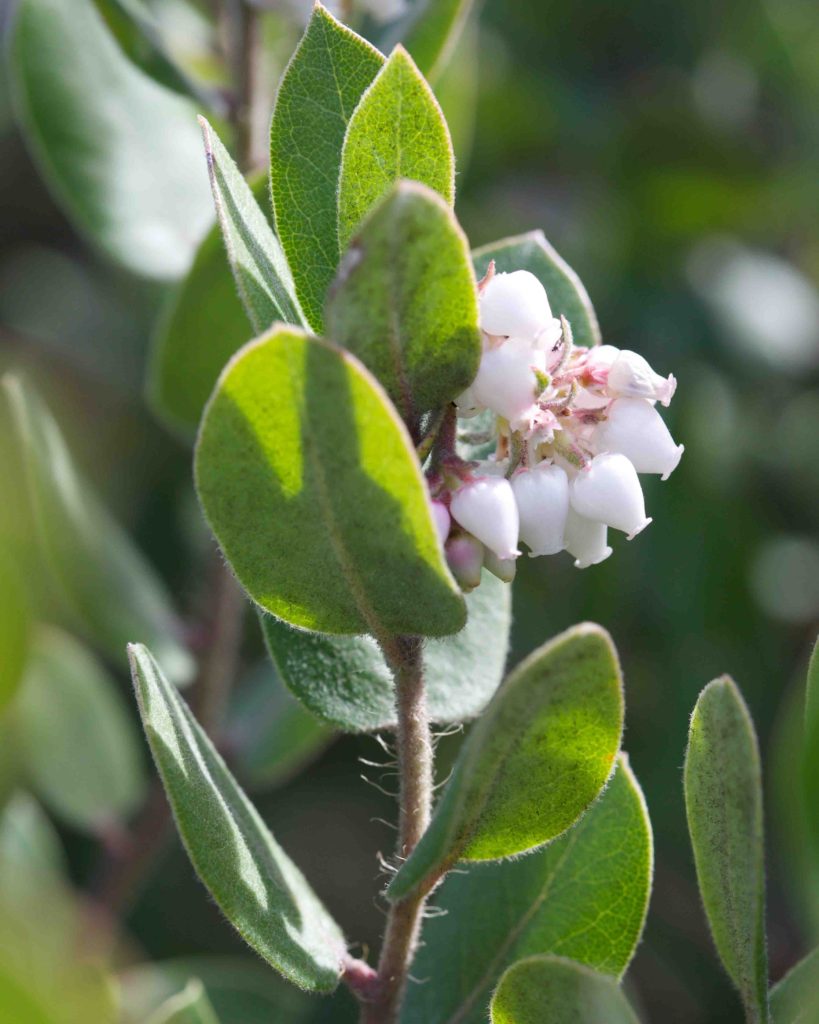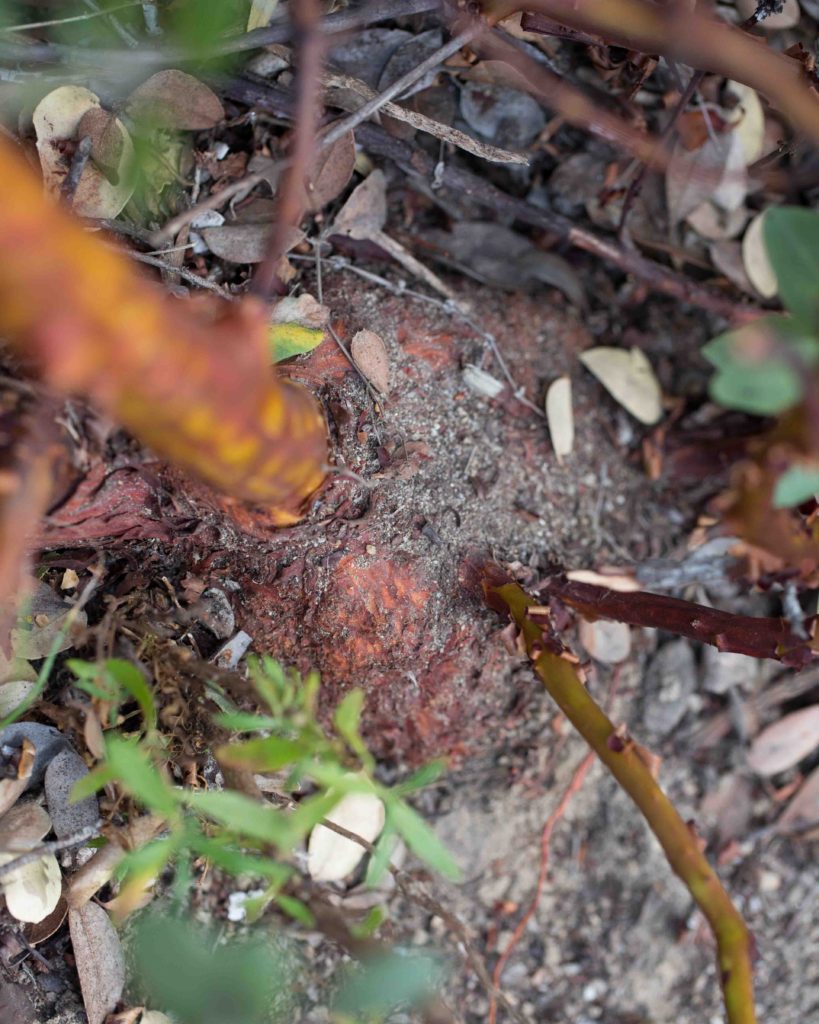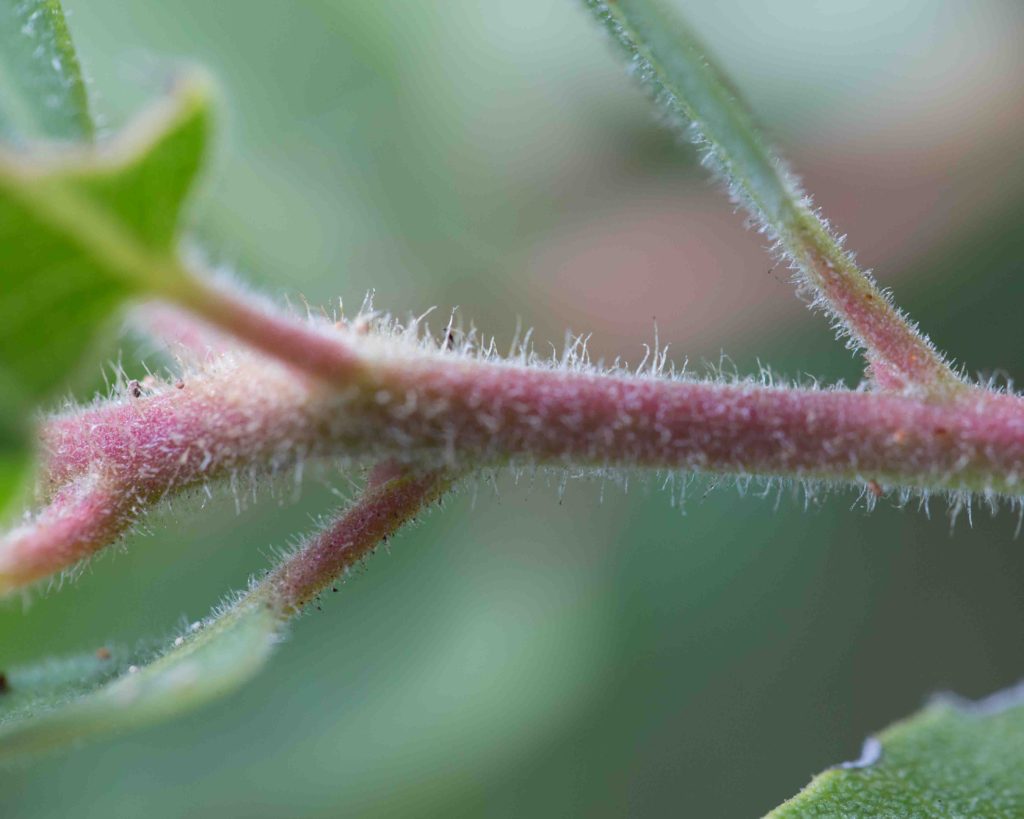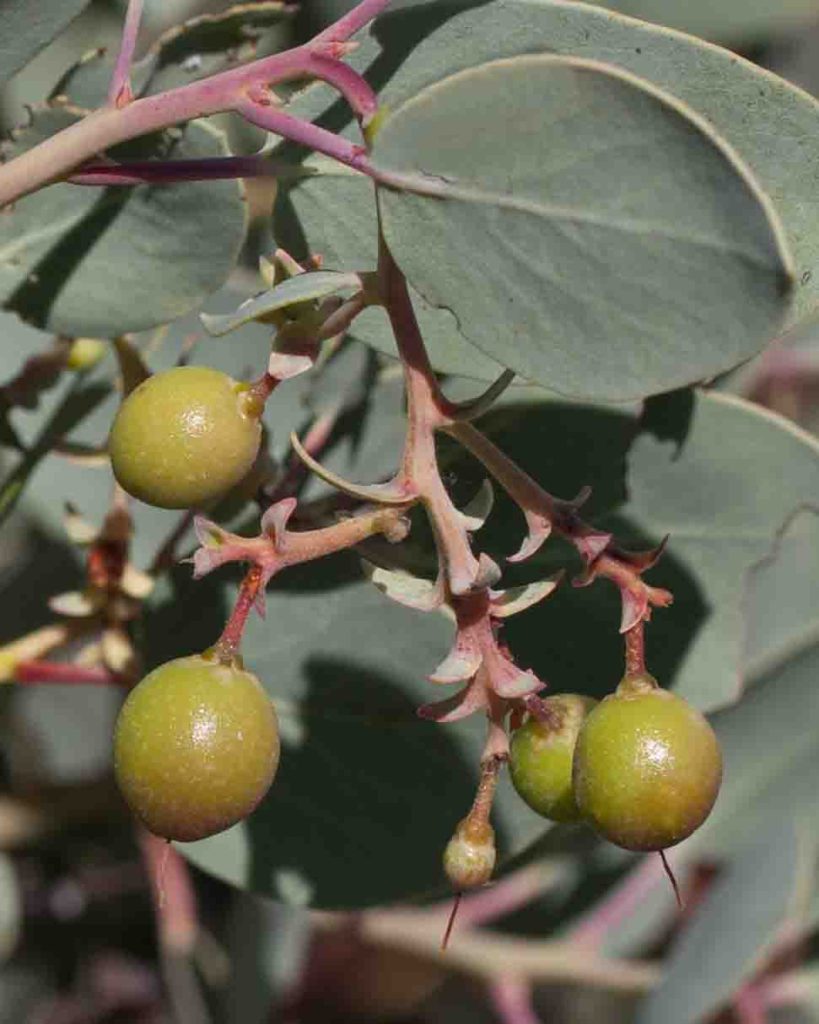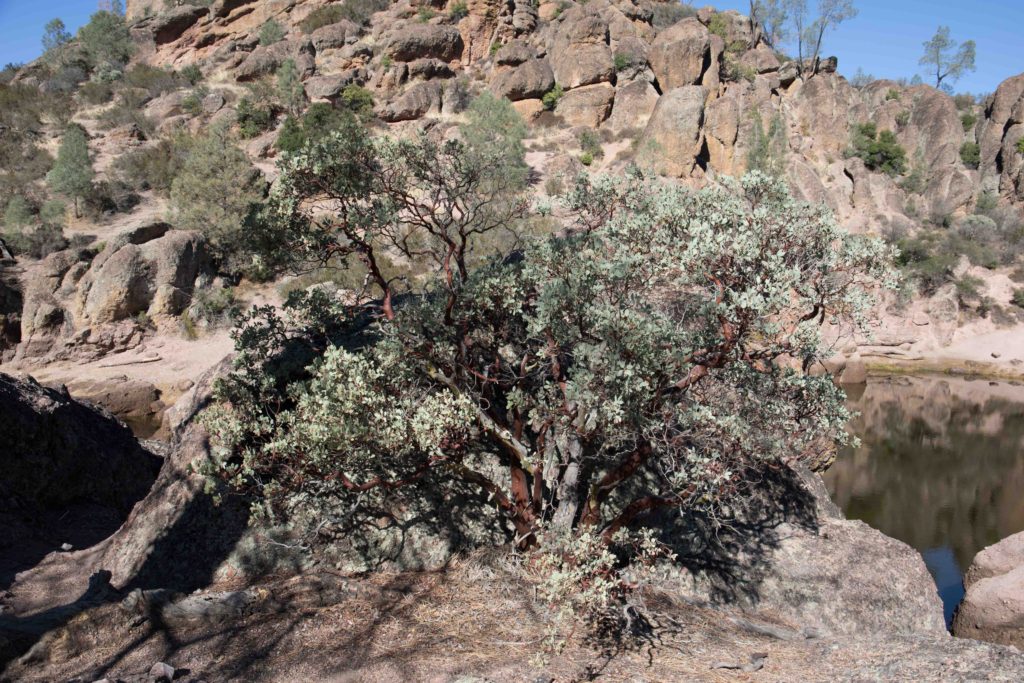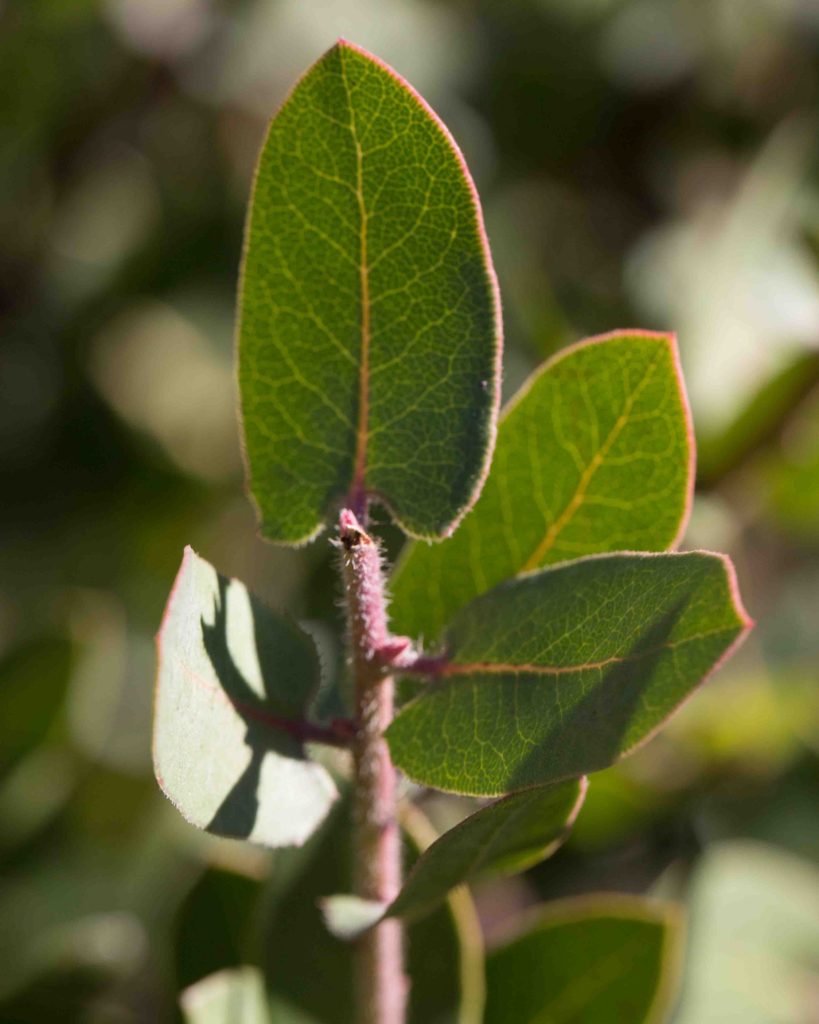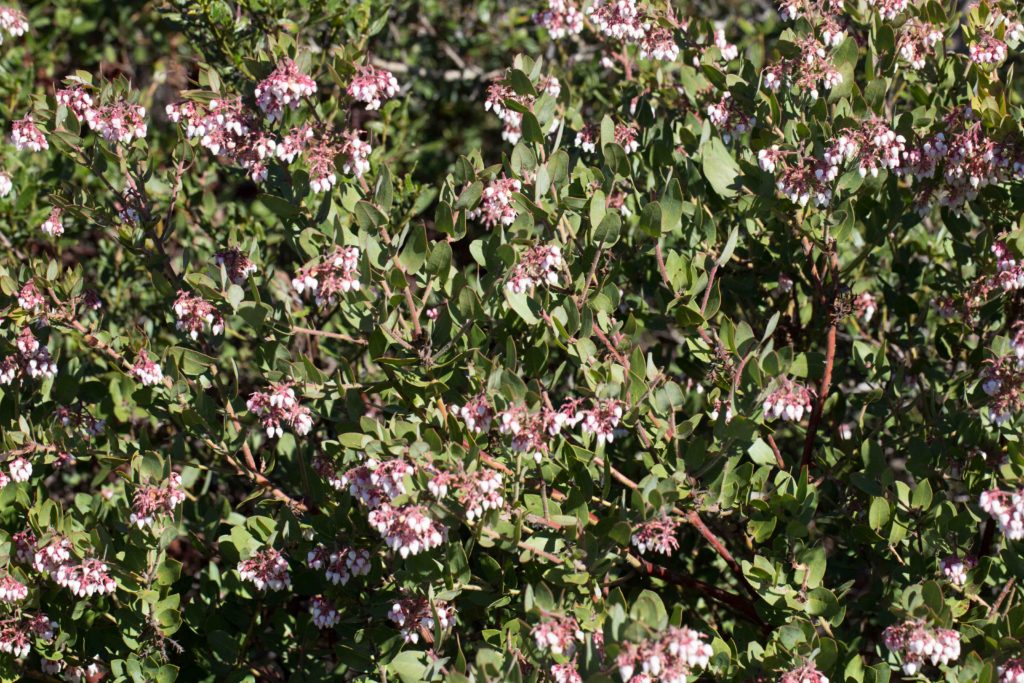Ericaceae: Heath Family — Arctostaphylos (Manzanita)
The Heath family is mostly chaparral shrubs with alternate evergreen leaves. Examples are Arctostaphylos (Manzanita), Vaccinium (Huckleberrry), as well as trees, such as Arbutus (Madrone). All these have pendulous, bell- or urn-shaped flowers. The family also includes Rhodododendron and Azalea, with showy, funnel-shaped flowers. Most prefer acidic soil.
Manzanitas are difficult to identify. All have similar flowers, and a range of features that frequently overlap more than one species. They are notorious for hybridizing, which results in a mix of features. Many examples will be found that will challenge the expert, let alone the layman.
The first thing to look for is whether the shrub has a burl at the base of the main stem. About 30% of manzanitas have one, and they resemble a rounded, knotty platform. Caution: if old leaves are piled up on the burl, it may be hard to see. A burl is a repository of dormant buds, which allows the plant to resprout from the base if the above-ground part of the shrub is destroyed in a wildfire.
Next, one has to consider the leaves. How they are growing, are they mainly erect (vertical), or are they spreading (leaning) to the sides? Are they similar in appearance on both surfaces? Are they tomentose (densely white-hairy), glabrous, or something in between? Are they glandular? The shape of the leaves, particularly the tips and the bases, can often distinguish the species. Other features to consider are the degree of hairiness, the presence or absence of glands, and the bark. Several species have shaggy bark, with subtle differences in their appearance.
Crinite Manzanita – Arctostaphylos crustacea subsp. crinita
Blooms:
Feb–Apr
Plant Height:
1–3 m
Flower Size:
Medium cluster
Origin:
Native
Habitat:
Chaparral & conifer forest
Notes:
Both this and Brittle-leaf Manzanita (subsp. crustacea, see below) have a prominent burl, spreading leaves 2–5 cm long on short (2–5 mm) petioles. Stems are reddish and bark may be peeling. However, this has leaves that are densely, non-glandular hairy below and occasionally above. Twigs and nascent inflorescences have both short and long stiff, non-glandular hairs.
Brittle-leaf Manzanita – Arctostaphylos crustacea subsp. crustacea
Blooms:
Feb–Apr
Plant Height:
1–3 m
Flower Size:
Medium cluster
Origin:
Native
Habitat:
Chaparral & conifer forest
Notes:
Both this and Crinite Manzanita (subsp. crinita, see above) have a prominent burl, spreading leaves 2–5 cm long on short (2–5 mm) petioles. Stems are reddish and bark may be peeling. However, this subspecies has leaves that are dark green and glabrous above, light green and non-glandular hairy below. Flowers are hairy but not glandular. The third photo shows the flowers being pollinated by a bee using the “buzz pollination” technique.
Eastwood’s Manzanita – Arctostaphylos glandulosa subsp. glandulosa
Blooms:
Jan–Apr
Plant Height:
1–4 m
Flower Size:
Medium cluster
Origin:
Native
Habitat:
Widespread in Santa Lucia Mountains
Notes:
Like Arctostaphylos crustacea (see above), this has a burl, hemispheric but not necessarily prominent. Stems have short hairs, glandular or not. Leaves are spreading but on longer petioles (5–10 mm). Leaves are variable, sometimes glandular and slightly hairy, rough to the touch, sometimes smooth. Flowers are glandular.
Big-berried Manzanita – Arctostaphylos glauca
Blooms:
Dec–Mar
Plant Height:
1–8 m
Flower Size:
Medium cluster
Origin:
Native
Habitat:
Chaparral, rocky slopes, woodland
Notes:
This manzanita does not have a burl. It is most easily distinguished by its glaucous, blue-gray leaves, ovate to roundish in shape and with a rounded base. The third photo shows a large specimen with a green-leaved manzanita in front of it, highlighting the difference in color. The fruits are spherical and large (10–15 mm). It can grow into a good-sized tree. It is very common in the Pinnacles, one of two species of manzanitas found there.
Hooker’s Manzanita – Arctostaphylos hookeri subsp. hookeri
Blooms:
Feb–Apr
Plant Height:
0.5–1.5 m
Flower Size:
Medium cluster
Origin:
Native
Rare or Endangered?
Yes – 1.b2
Habitat:
Chaparral & sandy places and woods near coast
Notes:
One of the more easily recognized manzanitas. It has small (2–3 cm), bright green leaves which are totally hairless, shiny, lanceolate to elliptic, with acute tips. The plant is fairly small and often forms a neat, low mound. It has no burl.
Toro Manzanita – Arctostaphylos montereyensis
Blooms:
Jan–Mar
Plant Height:
1–3 m
Flower Size:
Medium cluster
Origin:
Native
Rare or Endangered?
Yes – 1.b2
Habitat:
Ancient sand dunes
Notes:
Endemic to Monterey County, where it is found in coastal chaparral. This species does not have burls. It has shredding bark, leaving the older stems smooth and dark red. Leaves are erect, round to oblong-ovate and not overlapping. Leaf surfaces are bright green, more or less glaucous. The leaf base is rounded to truncate, and the tip is abruptly soft-pointed. Flower bracts are often red-tinged. Photo #2 by CJH.
Pajaro Manzanita – Arctostaphylos pajaroensis
Blooms:
Dec–Feb
Plant Height:
1–4 m
Flower Size:
Medium cluster
Origin:
Native
Rare or Endangered?
Yes – 1.b1
Habitat:
Chaparral, sandstone outcrops
Notes:
The only manzanita with both shredding bark and bifacial leaves (i.e. with differing upper and lower surfaces). It does not have burls. Leaves are overlapping, ovate to triangular ovate, with a red-tinged margin and are more or less clasping. Leaf surfaces are blue-green and glaucous above, pale green and glabrous below. Some specimens in Fort Ord may be hybrids with Toro Manzanita (Arctostaphylos montereyensis, see above).
Sandmat Manzanita – Arctostaphylos pumila
Blooms:
Feb–Apr
Plant Height:
10–100 cm
Flower Size:
Medium cluster
Origin:
Native
Rare or Endangered?
Yes – 1.b2
Habitat:
Sandy places near Monterey Bay
Notes:
Another Monterey County endemic. One of the smallest manzanitas, it forms a low mound, like Hooker’s Manzanita (Arcotstaphylos hookeri, see above) but can be distinguished from it by the color and size of its leaves. These are very small (1–2 cm), mid-green with a bluish tinge, glabrous above and blue-tomentose below (at least when young). The leaf base is wedge-shaped and the tip obtuse. It has no burl.
Mexican Manzanita – Arctostaphylos pungens
Blooms:
Feb–Mar
Plant Height:
1–3 m
Flower Size:
Medium cluster
Origin:
Native
Habitat:
Mainly around the Indians, widely distributed outside Monterey County
Notes:
This manzanita has no burl. Leaves are erect, bright or dark green on both surfaces, more or less elliptic and with an obtuse to wedge-shaped base. Ovaries and fruits are glabrous, the latter somewhat flattened and 5–8 mm across. One of the two species of manzanita found in the Pinnacles.
Monterey Manzanita – Arctostaphylos tomentosa subsp. bracteosa
Blooms:
Dec–Mar
Plant Height:
1–3 m
Flower Size:
Medium cluster
Origin:
Native
Habitat:
Chaparral, conifer forest
Notes:
This species of manzanita has a prominent burl and flaking bark. It is similar to Shaggy-barked Manzanita (subsp. tomentosa, see below). However, its leaves are not tomentose below, and twigs and inflorescences are densely glandular-hairy.
Shaggy-barked Manzanita – Arctostaphylos tomentosa subsp. tomentosa
Blooms:
Dec–Mar
Plant Height:
1–3 m
Flower Size:
Medium cluster
Origin:
Native
Habitat:
Chaparral, conifer forest
Notes:
This has a prominent burl and flaking bark, leading to its common name. Leaves are green above, but white-tomentose below. Leaves, twigs and flowers all have sparse, short, non-glandular hairs.

